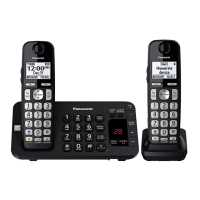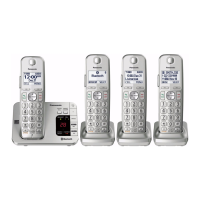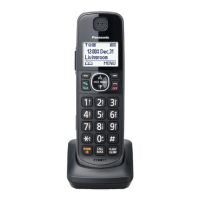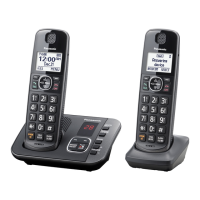What to do if my Panasonic KX-TGE434 Cordless Telephone handset beeps and/or flashes?
- KKayla RodriguezAug 14, 2025
If the handset beeps and/or flashes, the battery charge is likely low. Fully charge the batteries.
What to do if my Panasonic KX-TGE434 Cordless Telephone handset beeps and/or flashes?
If the handset beeps and/or flashes, the battery charge is likely low. Fully charge the batteries.
What to do if my Panasonic KX-TGE434 unit does not work?
First, make sure the batteries are installed correctly. Second, fully charge the batteries. Third, check the connections. If it still fails, unplug the base unit’s AC adaptor to reset the unit, then reconnect it. Finally, ensure the handset has been registered to the base unit.
Why I cannot hear a dial tone on my Panasonic KX-TGE434?
The base unit’s AC adaptor or telephone line cord may not be connected, so check those connections. If the connections are correct, disconnect the base unit from the telephone line and connect the line to a known working telephone. If the working telephone operates properly, contact service personnel to have the unit repaired. If the working telephone does not operate properly, contact your phone service provider.
Why is caller information not displayed on my Panasonic Cordless Telephone?
Several factors could be at play. First, you may need to subscribe to Caller ID service with your phone service provider. Second, if additional telephone equipment is connected, try plugging the unit directly into the wall jack. If you have DSL/ADSL service, connecting a DSL/ADSL filter between the base unit and the telephone line jack is recommended. It’s also possible that the name display service isn't available in your area, or other telephone equipment might be interfering with the unit. Disconnect any other equipment to test this.
What to do if my Panasonic KX-TGE434 handset does not turn on?
Place the handset on the base unit or charger to turn it on.
What to do if my Panasonic Cordless Telephone does not record new messages?
There are several reasons why your unit might not be recording messages. First, ensure that the answering system is turned on. Also, if the message memory is full, erase unnecessary messages. Check that the recording time is not set to 'Greeting only'. Also, your phone service provider’s voicemail may be answering calls too quickly; try changing the unit’s number of rings setting to a lower value. Finally, the answering system will not answer incoming calls while other devices are in use.
Why is the indicator on my Panasonic Cordless Telephone handset flashing slowly?
The indicator on the handset flashes slowly to indicate new messages or voicemail messages. Listen to the new messages or listen to the new voicemail messages.
Why does my Panasonic KX-TGE434 Cordless Telephone base unit beep?
The base unit beeps to indicate new messages. Listen to the new messages.
What to do if I fully charged the batteries of my Panasonic KX-TGE434 Cordless Telephone, but it still flashes?
Clean the battery ends and the charge contacts with a dry cloth and charge again. If the issue persists, it may be time to replace the batteries.
Details the physical components and model variations for different series.
Lists and describes supplied accessories with quantities for various models.
Notes on design changes and illustration variations from the actual product.
Information on how to obtain extra accessories or replacement parts.
Explains how to expand the phone system with optional handsets.
Explains the meaning of various symbols used on the equipment and in the manual.
Critical safety precautions to prevent injury and ensure proper operation.
Basic safety precautions to reduce risk of fire, electric shock, and injury.
Tips for optimal base unit placement and sound quality.
Guidelines for product placement and operating conditions.
Instructions for cleaning and maintaining the product.
Advice on data privacy and product end-of-life handling.
Technical details including standard, frequency, power, and operating conditions.
Step-by-step guide for connecting the base unit and installing batteries.
Instructions on how to charge handset batteries and view battery level.
Important notes regarding AC adaptor connection and battery installation.
Explanation of the eco mode feature for reducing power consumption.
Identification and function of buttons on the handset and base unit.
Explanation of various icons displayed on the handset screen.
How to change the display and voice announcement languages.
Procedure for setting the current date and time.
Steps to record a personalized greeting message for the answering system.
Configuration options for dialing mode.
Instructions for making calls using the handset and base unit.
How to redial the last dialed number.
How to adjust volume levels during a call.
How to insert a pause for PBX systems or long distance calls.
Procedures for answering calls using the handset and base unit.
Describes call holding, muting, and other in-call functions.
How to put a call on hold and resume it.
How to mute the microphone during a call.
Using the flash function for PBX features and call waiting.
How to use call waiting and Caller ID features.
How to use tone dialing for rotary/pulse lines.
Improves sound clarity in areas with interference.
Reduces background noise from the other party.
Enhances voice clarity for better understanding.
How to join an existing outside call for conferencing.
Procedures for transferring calls and setting up conference calls.
How to locate a misplaced handset by paging it.
Feature to locate a misplaced cellular phone.
How to assign a cellular phone number for the cell locator feature.
How to erase the stored cellular phone number.
How to use the cell locator function.
How to make intercom calls between units.
Steps to initiate an intercom call.
How to enable automatic intercom answering.
How the handset provides power during a failure.
How to block calls by adding numbers to a list.
Methods for blocking specific numbers or number ranges.
How the unit automatically blocks callers matching the list.
How to manually store a number to block.
Blocking numbers directly from the caller ID list.
Manually adding numbers to the block list.
Blocking calls that start with a specific number sequence.
Blocking calls with unknown or private caller IDs.
Option to mute the first ring for all calls or just blocked calls.
Managing numbers in the call block list.
Clearing the entire call block list.
How to add, store, and manage contact entries.
Step-by-step guide to adding new contacts.
How to input names and characters using the dial keys.
Saving numbers from the redial list into the phonebook.
Saving incoming call information to the phonebook.
Organizing contacts into groups for easier management and identification.
Customizing group names and assigning unique ringers.
How to search and make calls using phonebook entries.
Modifying existing phonebook entries.
Removing entries from the phonebook.
Procedure to delete a single phonebook entry.
Clearing all entries from the phonebook.
Dialing numbers from the phonebook during an active call.
Assigning phone numbers to dial keys for quick access.
Methods for adding numbers to speed dial.
How to view speed dial entries and make calls.
Modifying existing speed dial entries.
Removing a speed dial entry.
Accessing features via menu scrolling or direct command codes.
Overview of menu structure and associated command codes.
Settings for new message alerts, including outgoing call notifications.
General settings for the unit, including ring count and recording time.
Settings related to answering calls.
Accessing voicemail messages.
Features related to intercom functionality.
Setting the date, time, and memo alarms.
Managing speed dial entries.
Configuring ring adjustments, silent mode, and time settings.
Settings for announcing caller information.
Setup and management of key detectors.
Settings for blocking unwanted calls.
Settings for the cell locator feature.
Settings for recording greeting messages.
Voicemail settings.
Adjusting the screen contrast.
Setting custom names for handsets.
Displaying handset names.
Settings for automatic intercom calls.
Adjusting key tone settings.
Automatically editing caller ID numbers.
Settings for automatic call answering.
Configuring telephone line settings.
Managing call sharing for conferencing.
Registering new units like handsets.
Settings related to power failure operation.
Changing the unit's display and announcement language.
Accessing customer support information.
Setting and managing alarm functions.
Configuring silent mode to prevent ringing.
How to enable or disable silent mode.
Setting the active period for silent mode.
Allowing specific caller groups to ring during silent mode.
Using the baby monitor feature to listen to a remote room.
Procedures for setting up and using the baby monitor.
How to monitor a room using another unit.
Disabling the baby monitor feature.
Modifying the phone number for remote monitoring.
Removing a number for remote monitoring.
Adjusting the sensitivity level for the baby monitor feature.
Prerequisites and features of the Caller ID service.
Information displayed when an outside call is received.
How missed calls are indicated and cleared.
How stored names appear with incoming calls.
Announcing the caller's name or number.
Announcing caller names from the phonebook.
Managing the list of incoming calls.
How to view the caller list and make return calls.
Modifying phone numbers in the caller list.
Automatically adjusting caller ID formats.
Removing specific entries from the caller list.
Clearing the entire caller list.
Overview of the answering system's capabilities.
Information on recording capacity and message limits.
How to activate or deactivate the answering system.
Explanation of greeting messages and types.
Steps to record a custom greeting.
Using the unit's default greeting messages.
How to erase custom greetings and revert to pre-recorded ones.
How to play the greeting message.
Methods for listening to recorded messages.
How to play messages using the base unit.
Controls for playback, skipping, and erasing messages.
How to delete all recorded messages.
How to listen to messages using the handset.
Navigating the answering system menu.
Features to notify users of new messages.
Base unit beeps to alert of new messages.
Unit calls a specified number to notify of new messages.
Setting up a number for new message alert calls.
Activating or deactivating the alert call feature.
Modifying the phone number for alert calls.
Removing the phone number for alert calls.
Setting up remote access code for message playback.
Controlling the answering system remotely via phone.
Setting and managing the remote access code.
Removing the remote access code.
Step-by-step guide for remote operation.
Using voice prompts for remote operation.
How to initiate remote operation.
Configuring various answering system options.
Listening to callers while they leave messages.
Setting the number of rings before the unit answers.
Adjusting the maximum recording time per caller.
Setting the unit to only play greetings, not record messages.
Controlling the message indicator light on the handset.
Using voicemail services from the phone provider.
Entering the number to access voicemail automatically.
Removing the stored voicemail access number.
How the unit detects voicemail tones.
Enabling or disabling voicemail tone detection.
How to listen to voicemail messages.
Instructions for mounting the base unit on a wall.
How to detach the wall mounting hardware.
Instructions for installing the charger.
Common error messages and their solutions.
Solutions for common problems with the handset and base unit.
Troubleshooting common issues like handset not turning on or unit not working.
Troubleshooting issues related to menu display or handset registration.
Troubleshooting battery charging problems.
Troubleshooting call and intercom issues.
Troubleshooting Caller ID and related features.
Troubleshooting issues with the answering system.
Troubleshooting voicemail-related issues.
What to do if the unit is exposed to liquid.
Regulatory compliance and FCC information.
Information on hearing aid compatibility.
Information on how to get support and purchase accessories.
Details of the product's limited warranty coverage for the USA.
Specifics of what the warranty covers, including parts and labor.
Instructions for submitting repair requests online or via mail.
What is not covered by the product warranty.
| Brand | Panasonic |
|---|---|
| Model | KX-TGE434 |
| Type | Cordless Telephone |
| Frequency | 1.9 GHz |
| DECT 6.0 | Yes |
| Number of Handsets | 4 |
| Expandable Handsets | Yes |
| Answering System | Yes |
| Answering System Recording Time | 18 minutes |
| Caller ID | Yes |
| Call Block | Yes |
| Keypad Backlit | Yes |
| Speakerphone | Yes |
| Talking Caller ID | Yes |
| Power Failure Talk System | Yes |
| Display | LCD |
| Call Waiting | Yes |
| Intercom | Yes |
| Power Source | AC Adapter |
| Range | Up to 1000 feet |
| Battery Life | Up to 7 days standby |












